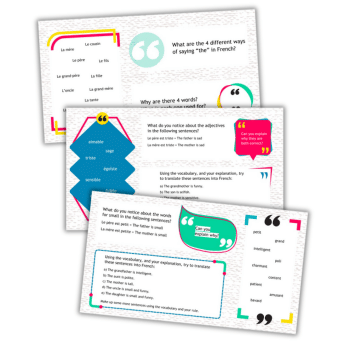Say Something! – A Lesson Plan To Get Your MFL Pupils Speaking Out Loud

Try Anthony Cahill's fresh ideas to encourage lively participation in target language conversation…

Getting pupils to speak spontaneously in the target language is the main goal of all MFL teachers – yet despite all of our efforts, achieving it can seem akin to conquering Everest.
It doesn’t matter how much of a safe environment we create, how much encouragement, support and (daily) bribery we use, the fact remains that speaking is most pupils’ nemesis. If and when we manage to persuade them to utter a few syllables, we are often faced with a barrage of pronunciation issues, from ‘Gente’ to ‘amABLE’; from ‘vacancES’ to ‘jouENT’, and a plethora of other crimes against language.
While there is no magic wand to put an end to these issues, here are a few ideas that may alleviate and help with the difficulties – and, hopefully, create more confident speakers.
Starter activity
A good starter activity to complete with a class is a ‘pronunciation pitfalls’ task. On a sheet of paper, pupils are given a list of words that contain letters (or combinations of letters) that are often mispronounced, as shown in the grid below.

The task for the pupils is to identify the letters that are difficult to pronounce, attempt the pronunciation with a partner, and then try to think of another word that contains the same combination of letters. The more that pupils are made actively to recognise these sounds, the more likely they are to remember.
Main activities
Task 1 A very useful task is to have pupils become markers. A recording is played and the students have to assess it using a GCSE mark scheme. Pupils can either mark the recording using all of the criteria – or, if the focus is pronunciation, then they just need to mark this aspect of the recording. The recording can be a specimen from the exam board website, if the activity is for GCSE pupils. With KS3 pupils, you could pre-record something by a GCSE or A level student.
At the end of the activity, pupils will share their marks and given justifications using the mark scheme. This task helps pupils to understand the importance of accent and pronunciation.
Task 2 Trying to encourage pupils to speak in the target language is often led by teachers asking questions and pupils answering in target language. This practice is commonplace in all MFL classrooms – however, what is also common is the range of pupils who will whisper to the person next to them “What does that mean?”
Having students understand what they are being asked is paramount, particularly with the new changes to GCSE. A helpful activity to make pupils think more carefully about questions is ‘MFL Jeopardy’, where the questions become the answers.
In this activity, the teacher provides an answer – for example, “Tengo dos hermanos y una hermana” – and the job for the pupils is to respond with the question; in this case, “¿Tienes hermanos?”
The complexity of the questions can vary, depending on the age range and ability of the pupils. You could also have other pupils provide the answers and have others try to provide the question. Task 3 An entertaining speaking activity which helps with spontaneity, is one where pupils have to provide one word as part of a sentence. This is best done in pairs or small groups, so that no learners sit idly for a prolonged period of time.
The activity works with one student saying a word and the next adding another logical word to the sentence, and so on. For example:
Pupil 1: Soy Pupil 2: alto Pupil 3: y Pupil 1: tengo Pupil 2: un Pupils 3: perro
The words they use can be sensible or a bit silly, so long as they make sense grammatically. This activity not only helps with more natural, free-flowing speech but it also helps with listening skills, as they have to rely on others to complete the task.
Task 4
Providing pupils with gap-fill exercises that contain a selection of words that they have to fit in the correct place in sentences is a daily occurrence in language lessons to support writing. However, a similar activity can help with speaking, too.
Students can be provided with a paragraph or sentences that contain gaps. The challenge is to read out loud and spontaneously fill the gap with any word of their choosing (providing it makes sense). For example:
Me llamo David y tengo dos ________ y un perro. Me gusta jugar al _________ .
The length of the sentence or paragraph will depend on the ability of the class. ou can also differentiate by making the gaps be: all nouns, all adjectives or all verbs.
Summary
A fun plenary idea that involves the entire class could be the ‘four chair challenge’. At the end of the lesson, place four chairs at the front of the room facing the class, then ask for four volunteers.
The rest of the class have to ask questions to one of the pupils on the chairs. If the student answers correctly, then they remain seated where they are. If they answer incorrectly, then they have to swap with the pupil who asked the question.
The aim is to be sitting on the chair by the end of the lesson; those who are can be rewarded with stickers, merits and so on. This is a quick activity that requires no planning and encourages pupils to speak.
Home learning
Having pupils voice their own characters is a great way to help them gain confidence in speaking, especially for those who feel embarrassed about ‘performing’ in front of their peers. There are some excellent websites where students can create a character (or avatar) and then record speech in their own voice for the character to deliver.
These recordings can then be accessed by teachers who can mark pronunciation. Alternatively they can be played on IWBs as the class can find them extremely entertaining.
Take it further
Running dictation is a lively activity to encourage speaking and team work, and also requires very little planning.
Stick a selection of phrases or a paragraph on one side of the room or corridor, and divide your pupils into pairs or teams of three and four. The pupils take it in turns to memorise as much of the phrase/paragraph as they can and then dictate it to someone else in the group, who writes it down. The group who finishes first (and is completely accurate) wins. If you have access to a large hall, then this is a great game to play there.
If you are fortunate enough to have sixth form students, try using them as LSAs during speaking activities. This is an excellent way to ensure that more pupils are receiving individual attention, and is especially helpful for shyer pupils who might dread speaking out loud in front of larger groups.
Anthony Cahill is the head of modern foreign languages at Hazelwick School in Crawley, West Sussex; for more information, visit www.hazelwick.org or follow @HazelwickSchool. Browse our resources for European Day Of Languages.












